“Horror” games come in many shapes, sizes, flavors, and colors. Some games take elements that are traditionally classified as horror and plant that content in the midst of some other game genre, calling it horror, yet failing to deliver on the promised scares. Other games simply set out to frighten the audience as many times as possible. Outlast is clear in its intention and successful in the majority of its execution — it wants to make you jump out of your seat, and it will do that more than anything else released in 2013. It falters, though, in how frequently it releases the tension it’s so precisely crafted to build, never allowing the player to become truly terrified about what might happen in the next room or around the next corner.
 Outlast’s greatest strength lies in the atmosphere it creates via the careful presentation of its setting. Exploring an isolated, dilapidated mental asylum in the middle of the night, sharing dark, narrow corridors with the criminally insane, is enough to put anyone on edge. Developer Red Barrels has enhanced the feeling of vulnerability, though, not only by disarming players completely (a tactic straight out of the Amnesia playbook), but by injecting a measure of sensory deprivation into the game’s core mechanics.
Outlast’s greatest strength lies in the atmosphere it creates via the careful presentation of its setting. Exploring an isolated, dilapidated mental asylum in the middle of the night, sharing dark, narrow corridors with the criminally insane, is enough to put anyone on edge. Developer Red Barrels has enhanced the feeling of vulnerability, though, not only by disarming players completely (a tactic straight out of the Amnesia playbook), but by injecting a measure of sensory deprivation into the game’s core mechanics.
Players witness most of what happens in Outlast’s asylum through the viewfinder of an infrared camcorder. This tool is a necessity, as a staggering portion of the grounds is shrouded in complete darkness, and would be unnavigable without the simultaneously comforting and unsettling green filter of clarity. The camcorder runs on batteries, so players feel compelled to conserve as much as possible, often leading to a slow, stop-motion unveiling of the space ahead as the camera clicks on, and off, and on again. And in those moments with the camera off, the sense that something horrible could emerge at any moment pervades.
 Despite its finely tuned dynamic lighting, enveloping soundscape, optimal horror setting, and innovative camcorder mechanic, Outlast misses the mark in the way it releases players from the grips of suspense, heightened via its presentation. As the game progresses, enemies are in the player’s face more and more frequently, as unavoidable fixtures in the set dressing that lack the unknown element that makes the initial atmosphere so effective. Barreling down hallways and looking for hiding places under beds and inside lockers every time a psychopath threatens to slash or pulverize our investigative protagonist gets old fast, and moments spent in the proximity of these enemies are characterized less by the fear of what might happen if they’re alerted than a feeling of fatigue toward what inevitably becomes a trial-and-error process.
Despite its finely tuned dynamic lighting, enveloping soundscape, optimal horror setting, and innovative camcorder mechanic, Outlast misses the mark in the way it releases players from the grips of suspense, heightened via its presentation. As the game progresses, enemies are in the player’s face more and more frequently, as unavoidable fixtures in the set dressing that lack the unknown element that makes the initial atmosphere so effective. Barreling down hallways and looking for hiding places under beds and inside lockers every time a psychopath threatens to slash or pulverize our investigative protagonist gets old fast, and moments spent in the proximity of these enemies are characterized less by the fear of what might happen if they’re alerted than a feeling of fatigue toward what inevitably becomes a trial-and-error process.
It’s the time between encounters that sells the experience, though. Treading slowly through the shadows, searching for information that reveals the deranged history of the establishment while simultaneously seeking an escape from its imprisoning walls, is the crux of Outlast’s horror, and as long as the real threats don’t show their grotesque faces, imagination and ignorance carry the fear further than those pursuers ever manage to do. The mystery of the asylum and the anticipation of the next gruesome sight that might be hidden somewhere inside keep the mind invested in this story and its resolution, whatever that may be. While it may be a shame that its actual dangers aren’t nearly as frightening as what the mind conjures while playing Outlast, the game’s power to strongly influence player emotion through its atmosphere is still very commendable.


















